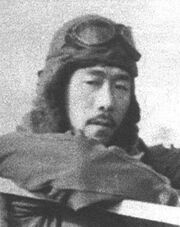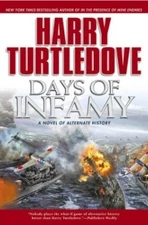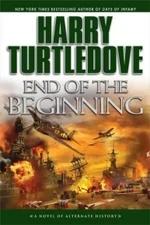ML4E (Message Wall | contribs) |
ML4E (Message Wall | contribs) mNo edit summary |
||
| Line 29: | Line 29: | ||
[[Category:Japanese]] |
[[Category:Japanese]] |
||
[[Category:Killed During World War II (Alternate Timeline)]] |
[[Category:Killed During World War II (Alternate Timeline)]] |
||
| + | [[Category:Blunt-Force Trauma Deaths (Fictional Work)]] |
||
| + | [[Category:Suicides (Fictional Work)]] |
||
[[Category:Navy Personnel of World War II]] |
[[Category:Navy Personnel of World War II]] |
||
[[Category:Pilots]] |
[[Category:Pilots]] |
||
Revision as of 19:06, 22 April 2014
| ||||||||||||||||||||||||||
Lieutenant Saburo Shindo (1911-2000) was a Japanese naval fighter pilot. He'd distinguished himself in China in 1940. He was one of the squadron leaders in the initial attack on Pearl Harbor on December 7, 1941, and is credited with sending the infamous "Tora, Tora, Tora" message, indicating that the surprise attack was a success.
Shindo survived the war, and appears to have died in relative obscurity.
Saburo Shindo in Days of Infamy
Saburo Shindo (1911-1943) was a Japanese fighter pilot who participated in the Japanese invasion of Hawaii from 1941-1942. He was instrumental in convincing Chuichi Nagumo to continue with the invasion December 7, 1941. Shindo led his squadron against the aircraft carrier USS Enterprise, sinking it.
Shindo remained in Hawaii during the was part of the first line of defense for Hawaii. He participated in the battle against the USA's first attempt to retake Hawaii in 1942, shooting down several Wildcats. However, after this success, Shindo found himself frustrated by the tactics employed by the U.S., including night-raids and submarine attacks. He was able to sink one American sub in 1943, one of the few Japanese pilots to do so.
In summer of 1943, Shindo met the invading U.S. force intent on retaking the islands. He was astonished by the vast improvement the new American Hellcat fighters were over the old Wildcats. They also outclassed the Zero. Shindo was able to shoot a few down, but was forced to retreat when the Japanese aircraft carrier Akagi was sunk. He landed at the Haleiwa airstrip, his plane damaged but still usable.
He continued to fly missions from whatever land airstrip was available and undamaged. He and the surviving Japanese flyers attacked the U.S. Marine landings at at the northern beaches but were unsuccessful in driving them off. To his mortification, his Zero was destroyed on the ground by attacking American aircraft.
He was unable to get back in the air until mechanics scrounged together a makeshift Zero. Shindo was the only pilot left uninjured, so he was allowed to fly it. Being resigned to death from the moment he took off, Shindo was arguably Japan's first kamikaze pilot. He was able to shoot down one Wildcat, and drop a bomb on the American escort carrier Copahee. No sooner had he done this than his engine quit. He flew his plane directly into the flight deck of the next aircraft carrier on his flight path, the Bunker Hill, while screaming "banzai".
| |||||||||||||||||


